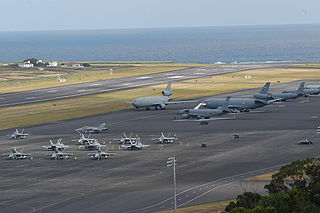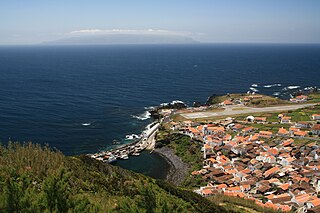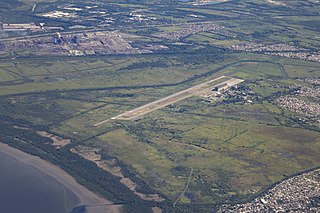Related Research Articles

The Brazilian Air Force is the air branch of the Brazilian Armed Forces and one of the three national uniformed services. The FAB was formed when the Army and Navy air branches were merged into a single military force initially called "National Air Forces" in 1941. Both air branches transferred their equipments, installations and personnel to the new force.

Lajes Field or Lajes Air Base, officially designated Air Base No. 4, is a multi-use airfield near Lajes and 15 km (9.3 mi) northeast of Angra do Heroísmo on Terceira Island in the Azores, Portugal. It is home to the Portuguese Air Force Base Aérea N º4 and Azores Air Zone Command, a United States Air Force detachment unit, and a regional air passenger terminal. Located about 3,680 km (2,290 mi) east of New York City and about 1,600 km (990 mi) west of Lisbon, Portugal; the base sits in a strategic location midway between North America and Europe in the north Atlantic Ocean.

Campo de Marte Airport is the first airport built in São Paulo, Brazil, opened in 1929. It is named after Champ de Mars, in Paris, which in turn got its name from Campus Martius, in Rome.

The Portuguese Air Force is the aerial warfare force of Portugal. Locally it is referred to by the acronym FAP but internationally is often referred to by the acronym PRTAF. It is the youngest of the three branches of the Portuguese Armed Forces.

Corvo Airport is an airport in the village of Vila do Corvo on the island of Corvo, in the Portuguese archipelago of the Azores. It is owned by the Regional Government of the Azores, but managed by SATA Air Açores.

Pico Airport is an airport located 8 km (5.0 mi) from Madalena on the Portuguese island of Pico in the archipelago of the Azores.

The Portuguese Naval Aviation constituted the air component of the Portuguese Navy, from 1917 to 1957. The Portuguese Air Force maritime patrol units and the Navy's Helicopter Squadron are the present successors of the former Portuguese Naval Aviation.
The Army Light Aviation Unit was the planned aviation unit of the Portuguese Army. Created in 2000 as the Army Light Aviation Group (GALE), it was the Army's unit dedicated to missions of light aviation, being integrated in the Army Forces System, under the operational command of the Ground Forces Operational Command. It was planned to be equipped with light fire support and medium maneuver helicopters. The process of helicopter procurement, however, suffered successive setbacks until being finally canceled in 2012, causing the unit disbandment in 2015.

Captain Luis Francisco Gómez Niño Air Base (Spanish: Base Aérea Capitán Luis Francisco Gómez Niño, also known as Apiay Air Base, is a Colombian military base assigned to the Colombian Aerospace Force Combat Air Command No. 2. It also hosts members of the Colombian Army and Colombian Navy. The base is located in Apiay, near the city of Villavicencio, in the Department of Meta in central Colombia, by the steps of the Andes mountain range and the plains of the Colombian Llanos.

Campo Grande International Airport, sometimes also informally referred to as Antônio João Airport, after the neighborhood where it is located, is the airport serving Campo Grande, Brazil.

São Jacinto Airfield, officially designated Aveiro Municipal Aerodrome, is an aerodrome near the city of Aveiro in Portugal. It is located on a peninsula, between the Atlantic Ocean and the Vouga River estuary, in the parish of São Jacinto, near to the harbour of Aveiro, as well as the Costa de Prata beaches. It has a single runway in the 17/35 direction and a relatively large apron and has been operated in the past by all branches of the Portuguese Armed Forces. It is home to an air club, Aeroclube de Aveiro, but is currently closed to civilian traffic due to lack of certification.

Santa Cruz Air Force Base – ALA12 is a base of the Brazilian Air Force, located in the district of Santa Cruz in Rio de Janeiro, Brazil.

Jacarepaguá–Roberto Marinho Airport is an airport in the neighborhood of Barra da Tijuca, Rio de Janeiro, Brazil dedicated to general aviation. Following extensive renovation in 2008 the airport was renamed after Roberto Pisani Marinho (1904–2003), a journalist and former president of Globo Network. It is a major helibase for offshore support.

Afonsos Air Force Base – BAAF is a base of the Brazilian Air Force, located in the district of Marechal Hermes, in Rio de Janeiro, Brazil.
Cachimbo Airport is the military airport serving Campo de Provas Brigadeiro Velloso, a large Testing and Training complex of the Brazilian Armed Forces located in Serra do Cachimbo, in the southern part of the state of Pará, Brazil. It is operated by the Brazilian Air Force.
Aviation in the Azores is part of the greater history of aviation in Portugal, and involves the historical use of the archipelago of the Azores by North American, South American and European pioneers of aviation. The Azores is strategically located in the centre of the North Atlantic Ocean between the continents of North America and Europe, and has played a historical role in trans-Atlantic navigation. The three primary airfields of the Azores are:

Octavio Moura Andrade Municipal Airport, often referred to as São Pedro Airport, is the airport serving São Pedro, Brazil.

The Portuguese Air Force (PoAF) has operated Sud Aviation Alouette III light utility helicopters since 1963. The Portuguese government originally purchased 142 helicopters to replace the Sud Aviation Alouette II and for use in the roles of tactical transport, medical evacuation, and flight training, with several being adopted for combat air support.
References
- "Comando Aéreo" [Air Command] (in Portuguese). Portuguese Air Force. Archived from the original on February 28, 2014. Retrieved March 17, 2014.
- ↑ Lusa, Agência. "Exército cria Centro de Guerra da Informação e Ciberdefesa". Observador (in European Portuguese). Retrieved 2023-02-06.